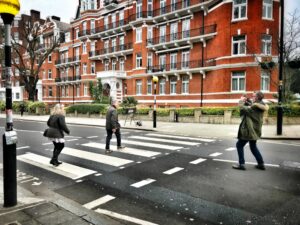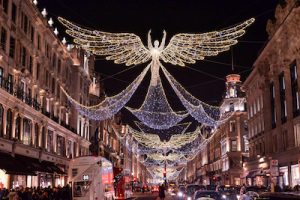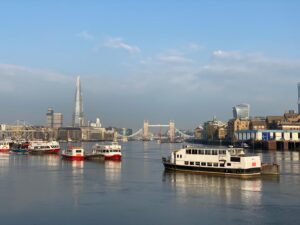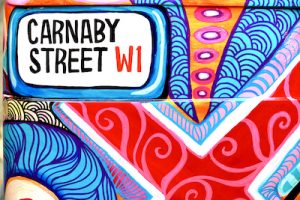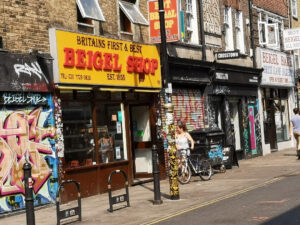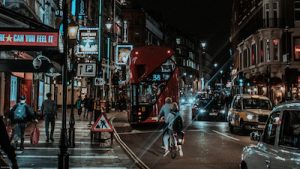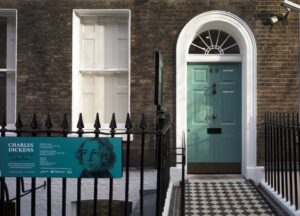20 Famous Streets In London To Visit
Date post added: 8th April 2025
Every city has its famous streets, like Times Square in New York and the Champs-Elysées in Paris. London though has far more than its fair share of well-known roads. Interestingly, in ancient times, streets were urban and roads went through the countryside. So famous London roads like Abbey Road remind us that these areas haven’t always been urban.
What’s the most popular street in London? That’ll be perennial favourite, Oxford Street, and you can find out why below. What is the prettiest street in London? Many vie for that title, but the colourful and charming, Portobello Road is a popular choice.
From the bright lights of Shaftesbury Avenue to the chic Kings Road, the vibrancy of Brick Lane to the grandeur of The Mall, here’s our round up of 20 famous London streets. In true London Walks style, we’ll be delving into their history too.
1. Abbey Road
This road in St. John’s Wood shot to fame on 8th August 1969 when The Beatles walked across the zebra crossing on Abbey Road, a minute’s walk from EMI Studios where the fab four were recording their last album. It was only after the release of Abbey Road that EMI Studios changed its name to Abbey Road Studios. Today, around 1000 people visit this London street every single day to recreate the famous Beatles Abbey Road album cover. For the full experience, join our Beatles walking tour which goes every Tuesday and Saturday at 11am.
2. Oxford Street
Stretching from Tottenham Court Road to Marble Arch, Oxford Street is the most popular in London. A super busy, must-visit shopping streets in England, Oxford Street is packed with high street retailers and the remaining iconic British department stores like Selfridges and John Lewis. Don’t let its modern day façade fool you into thinking that it’s merely a famous shopping street though, as Oxford Street is one of London’s most historic roads too. Once known as Tyburn Street, this stretch of London road from High Holborn in the north to Oxford Street in the west was once the last journey of prisoners heading to the gallows at Marble Arch. On a lighter note, just behind this famous London street, is the more hidden gem that is Marylebone High Street with its very different vibe and an array of beautiful boutiques and eateries.
3. The Mall
With its tree lined, red ‘carpet’ leading right up to Buckingham Palace, The Mall is one of the most famous of all London streets. This is the grand processional route for royal weddings and British celebrations. Like nearby Pall Mall, which was once an ancient highway believed to date back as far as Saxon times, The Mall is named after the 17th century game Pelle Melle, introduced by King Charles II. There’s plenty to see around here and the Royal London walking tour is the best way to discover it all.
4. Regent Street
One of London’s most popular streets thanks to its legendary Christmas lights, but there’s a strong royal connection too. Regent Street was named after the Prince Regent, King George IV, who came up with the idea for a new road to connect Carlton House (his town residence) with Regent’s Park. But it was British brands like Hamleys and Liberty moving into Regent Street in the late 1800s that cemented its fame as a shopping street.
5. The Strand
Home to 5 star hotel The Savoy, the famous Adelphi Theatre, and close to Somerset House, The Strand (or Strand) is one of London’s most important streets running from Temple Bar to Trafalgar Square. Named after the old Germanic word meaning ‘bank’ or ‘shore’, The Strand ran along the north bank of the Thames, back before the Thames was embanked and it was much wider. The Strand leads onto Fleet Street, yet Strand is in Westminster whilst Fleet Street is in the City of London. The Temple Bar gateway marked the boundary and the place where the monarch would be met by the Lord Mayor of London to ask permission to enter the city.
6. The Thames
It’s not a street we hear you cry, but when you look at an old map of London, you’ll see that the whole city was oriented to its river making it one of London’s most vital streets. No Thames, no London. Today, lots of London street names derive from ancient words for river or stream- ‘burn’ or ‘bourne’, like Kilburn and Holborn. Want to find out more? You need our Thames sightseeing tour.
7. Piccadilly
“It’s like Piccadilly Circus in here,” is a common exclamation from Brits when somewhere is really busy. It’s all thanks to Piccadilly, one of London’s best and most exciting streets! Running from Hyde Park Corner to Piccadilly Circus, Piccadilly in the City of Westminster is where you’ll find the likes of Fortnum & Mason and 5 star hotels such as The Ritz. The nearby Green Park tube station makes it an easy place to visit as well. Our walking tour ‘A Village in Picadilly’ is a great way to discover the area and little known secrets. Did you know that Piccadilly was once known as Portugal Street? The current name came from piccadills, which were types of ruffled collars.
8. Carnaby Street
Carnaby Street secured its place on the list of London’s most famous streets in the swinging 60s when it was frequented by The Rolling Stones, Jimi Hendrix and The Kinks. And who can forget the chart topping Carnaby Street by The Jam? Today, people visit Carnaby Street for its quirky boutiques and vibrant street art. It’s also a glittering gateway to Soho, and the LGBTQ+ hub of Old Compton Street in particular. Yet beneath its cool exterior, Carnaby Street has a macabre secret, with the area used as a mass burial ground for plague victims in the 17th century.
9. Baker Street
“Winding your way down on Baker Street,” sang Gerry Rafferty in his 1978 hit. But it’s not just Rafferty that put Baker Street on the map. In 1887, Arthur Conan Doyle released the first Sherlock Holmes story, A Study in Scarlet. Fictional detective Holmes and sidekick Watson were said to live at 221b Baker Street, an address that didn’t exist at the time as Baker Street didn’t extend north of Marylebone Road. Today though, you’ll find the Sherlock Holmes Museum at that famous address, 221b Baker Street.
10. Savile Row
Savile Row is known throughout Europe as London’s most famous street for men’s bespoke tailoring. From Huntsman and Gieves & Hawkes with their impeccable British credentials to more contemporary offerings, Savile Row and its talented tailors have a roster of famous fans. Named after Lady Dorothy Savile, Savile Row in London’s affluent Mayfair started to gain its reputation for tailoring in the 1800s.
11. Brick Lane
One of the oldest parts of London’s East End, Brick Lane earned its name thanks to the tile garths that existed in the area, making bricks or tiles. Today, Brick Lane is a melting pot of cultures and flavours, with some of the best street food, curry houses, cafés and vintage clothing stores in London. At the Shoreditch end of the street, you’ll find the finest Brick Lane bagels originating from the Jewish community. Its Bangladeshi community ensure the curry houses serve up flavoursome, authentic food daily. Then Brick Lane market will give you a taste of everything – street food alongside independent, eclectic retailers selling anything from vintage clothing to artwork and antiques. There’s so much to discover in this area and our walking tours ‘Unknown East End‘ or ‘Street Art‘ are wonderful ways to do it.
12. Bond Street
Some say it was 19th Century dandy George ‘Beau’ Brummell who catapulted Bond Street to fame. Others say it happened much earlier, when Lord Horatio Nelson lived there in 1798 (the blue plaque is there to prove it). Today though, Bond Street’s fame is indelibly linked to its plethora of luxury stores, from Jimmy Choo and Louis Vuitton on New Bond Street to Prada and Tiffany & Co. on Old Bond Street.
13. Shaftesbury Avenue
Just a stone’s throw from the glitzy Leicester Square and bustling Covent Garden, Shaftesbury Avenue is in the heart of theatre-land in London’s West End. Home to the Shaftesbury Theatre, the Sondheim Theatre and the Palace Theatre, as well as the marvellous (ok, nearby) Foyles bookstore, it’s a cultural hotspot.
14. Portobello Road
Without doubt, one of the most famous streets in London is Downing Street. 10 Downing Street is, of course, the official residence of the Prime Minister. Located in central London and close to early Roman settlements, Downing Street was home to the Axe brewery in the Middle Ages. Henry VIII built Whitehall Palace here, which was later destroyed by fire, and at the time was known as ‘the forbidden city’. And with all the security surrounding this famous London address, Downing Street could still be considered the forbidden city!
15. Downing Street
Without doubt, one of the most famous streets in London is Downing Street. 10 Downing Street is, of course, the official residence of the Prime Minister. Located in central London and close to early Roman settlements, Downing Street was home to the Axe brewery in the Middle Ages. Henry VIII built Whitehall Palace here, which was later destroyed by fire, and at the time was known as ‘the forbidden city’. And with all the security surrounding this famous London address, Downing Street could still be considered the forbidden city!
16. Columbia Road
Every Sunday from 8am Columbia Road is filled with the sight and scent of all types of plants, shrubs and freshly cut flowers when its famous flower market opens. Established as an indoors marketplace by Lady Angela Burdett-Coutts in the Victorian era (1869) as part of efforts to improve East London. It later reopened as an outdoor flower market, modelled on the outdoor markets seen in Covent Garden.
17. Jermyn Street
It’s had a raft of famous former inhabitants including Sir Isaac Newton and fans including Beau Brummell (look out for his statue). Its modern day appeal stems from its fame as the go-to street in London for men’s fine tailors, but Jermyn Street was never intended as a shopping destination. When Henry Jermyn, Earl of St Albans received approval for 23 plots on ‘Jarman Streete’, it became a residential neighbourhood. By 1815, Jermyn Street was home to many hotels too.
18. King’s Road
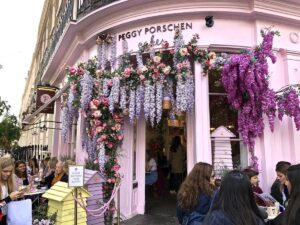
Photo by HerryLawford is marked with CC BY 2.0.
It was originally built for King Charles II as a private royal road to link St James’s Palace to Fulham. Yet King’s Road in Chelsea earned its fame for something rather different – as the place to party! After a brief stint when it was known as Cemetery Road, King’s Road came into its own in the 60s with the arrival of young, exciting fashions courtesy of Mary Quant, espresso bars and an anything-is-possible vibe. Then, in the 70s it was the home of punk culture which seems hard to imagine now with its high end boutiques and refined, rather than rebellious, clientele.
19. St. James Street
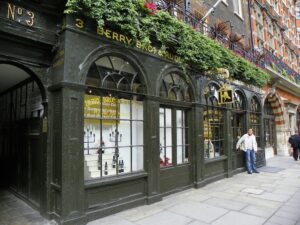
“Berry Bros and Rudd, St james, London” by Richard Randall
The street where Byron “awoke to find myself famous.” And just off it, the tiny courtyard where the last duel in London was fought. Not to mention the Texas Embassy and London’s oldest and most accessible palace. So many tides of history have washed through this old street. Coffee houses, chocolate houses, gentlemen’s clubs, courtiers and royal mistresses. And a lot of that history is still there – the gentlemen’s clubs, royal warranted luxury shops like Lock & Co the hatters, John Lobb the eye-wateringly expensive shoemaker, and Berry Bros the vintner who supplies the royal family’s wine.
20. Doughty Street
It may not be as well known as the likes of Oxford Street or Piccadilly, but Doughty Street still deserves its place in our list. Famous for being the street where the last remaining London home of Charles Dickens sits, 48 Doughty Street in Camden is now home to the Charles Dickens Museum. Close to Doughty Street was the Foundling Hospital, which cared for deserted children, and was the inspiration for a number of Dickens’ novels. Join us for more Dickens’ inspiration on our Charles Dickens’ London walk.
Famous and infamous London streets
Get the dirt and the hidden truth behind famous London streets. From Mayfair to Covent Garden, Soho to Portobello Road, our guides know the tales and folklore and they’re happy to spill the beans. Join them on a London walk!

